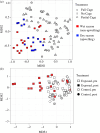Biogeographic and seasonal differences in consumer pressure underlie strong predation in the tropics
- PMID: 38955327
- PMCID: PMC11334995
- DOI: 10.1098/rspb.2024.0868
Biogeographic and seasonal differences in consumer pressure underlie strong predation in the tropics
Abstract
Biotic interactions play a critical role in shaping patterns of global biodiversity. While several macroecological studies provide evidence for stronger predation in tropical regions compared with higher latitudes, results are variable even within the tropics, and the drivers of this variability are not well understood. We conducted two complementary standardized experiments on communities of sessile marine invertebrate prey and their associated predators to test for spatial and seasonal differences in predation across the tropical Atlantic and Pacific coastlines of Panama. We further tested the prediction that higher predator diversity contributes to stronger impacts of predation, using both direct observations of predators and data from extensive reef surveys. Our results revealed substantially higher predation rates and stronger effects of predators on prey in the Pacific than in the Atlantic, demonstrating striking variation within tropical regions. While regional predator diversity was high in the Atlantic, functional diversity at local scales was markedly low. Peak predation strength in the Pacific occurred during the wet, non-upwelling season when ocean temperatures were warmer and predator communities were more functionally diverse. Our results highlight the importance of regional biotic and abiotic drivers that shape interaction strength and the maintenance of tropical communities, which are experiencing rapid environmental change.
Keywords: biotic interactions; predation; temperature; top-down control; tropical; upwelling.
Conflict of interest statement
We declare we have no competing interests.
Figures







References
-
- Menge BA, Sutherland JP. 1976. Species diversity gradients: synthesis of the roles of predation, competition, and temporal heterogeneity. Am. Nat. 110 , 351–369. ( 10.1086/283073) - DOI
-
- Schemske DW. 2009. Biotic interactions and Speciation in the tropics. In Speciation and patterns of diversity (eds Butlin R, Bridle J, Schluter D), pp. 219–239. Cambridge, UK: Cambridge University Press.
MeSH terms
Grants and funding
LinkOut - more resources
Full Text Sources
